NVIDIA GeForce GTX 680 Review: Retaking The Performance Crown
by Ryan Smith on March 22, 2012 9:00 AM ESTCompute: What You Leave Behind?
As always our final set of benchmarks is a look at compute performance. As we mentioned in our discussion on the Kepler architecture, GK104’s improvements seem to be compute neutral at best, and harmful to compute performance at worst. NVIDIA has made it clear that they are focusing first and foremost on gaming performance with GTX 680, and in the process are deemphasizing compute performance. Why? Let’s take a look.
Our first compute benchmark comes from Civilization V, which uses DirectCompute to decompress textures on the fly. Civ V includes a sub-benchmark that exclusively tests the speed of their texture decompression algorithm by repeatedly decompressing the textures required for one of the game’s leader scenes. Note that this is a DX11 DirectCompute benchmark.
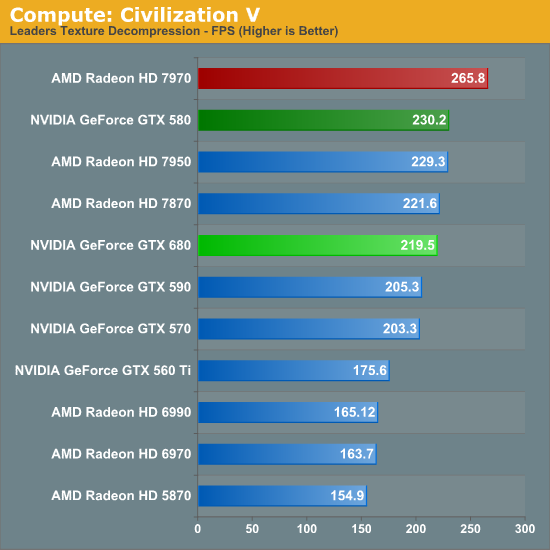
Remember when NVIDIA used to sweep AMD in Civ V Compute? Times have certainly changed. AMD’s shift to GCN has rocketed them to the top of our Civ V Compute benchmark, meanwhile the reality is that in what’s probably the most realistic DirectCompute benchmark we have has the GTX 680 losing to the GTX 580, never mind the 7970. It’s not by much, mind you, but in this case the GTX 680 for all of its functional units and its core clock advantage doesn’t have the compute performance to stand toe-to-toe with the GTX 580.
At first glance our initial assumptions would appear to be right: Kepler’s scheduler changes have weakened its compute performance relative to Fermi.
Our next benchmark is SmallLuxGPU, the GPU ray tracing branch of the open source LuxRender renderer. We’re now using a development build from the version 2.0 branch, and we’ve moved on to a more complex scene that hopefully will provide a greater challenge to our GPUs.
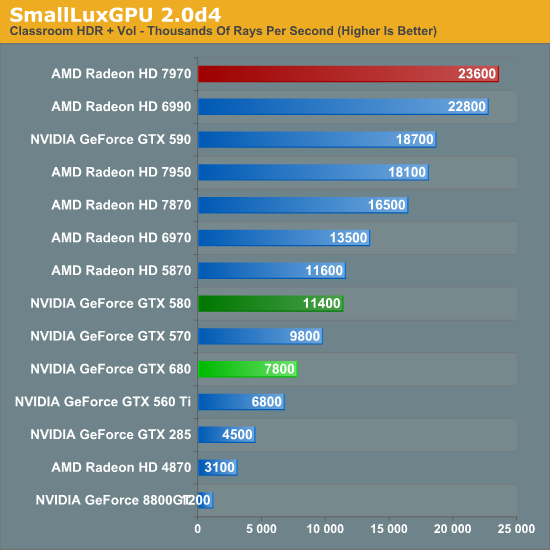
CivV was bad; SmallLuxGPU is worse. At this point the GTX 680 can’t even compete with the GTX 570, let alone anything Radeon. In fact the GTX 680 has more in common with the GTX 560 Ti than it does anything else.
On that note, since we weren’t going to significantly change our benchmark suite for the GTX 680 launch, NVIDIA had a solid hunch that we were going to use SmallLuxGPU in our tests, and spoke specifically of it. Apparently NVIDIA has put absolutely no time into optimizing their now all-important Kepler compiler for SmallLuxGPU, choosing to focus on games instead. While that doesn’t make it clear how much of GTX 680’s performance is due to the compiler versus a general loss in compute performance, it does offer at least a slim hope that NVIDIA can improve their compute performance.
For our next benchmark we’re looking at AESEncryptDecrypt, an OpenCL AES encryption routine that AES encrypts/decrypts an 8K x 8K pixel square image file. The results of this benchmark are the average time to encrypt the image over a number of iterations of the AES cypher.
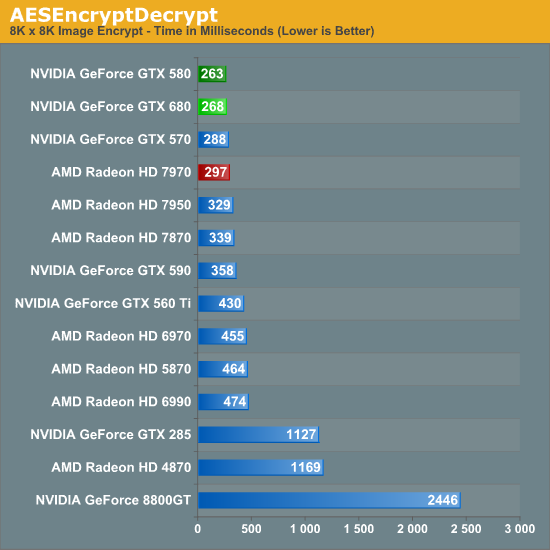
Starting with our AES encryption benchmark NVIDIA begins a recovery. GTX 680 is still technically slower than GTX 580, but only marginally so. If nothing else it maintains NVIDIA’s general lead in this benchmark, and is the first sign that GTX 680’s compute performance isn’t all bad.
For our fourth compute benchmark we wanted to reach out and grab something for CUDA, given the popularity of NVIDIA’s proprietary API. Unfortunately we were largely met with failure, for similar reasons as we were when the Radeon HD 7970 launched. Just as many OpenCL programs were hand optimized and didn’t know what to do with the Southern Islands architecture, many CUDA applications didn’t know what to do with GK104 and its Compute Capability 3.0 feature set.
To be clear, NVIDIA’s “core” CUDA functionality remains intact; PhysX, video transcoding, etc all work. But 3rd party applications are a much bigger issue. Among the CUDA programs that failed were NVIDIA’s own Design Garage (a GTX 480 showcase package), AccelerEyes’ GBENCH MatLab benchmark, and the latest Folding@Home client. Since our goal here is to stick to consumer/prosumer applications in reflection of the fact that the GTX 680 is a consumer card, we did somewhat limit ourselves by ruling out a number of professional CUDA applications, but there’s no telling that compatibility there would fare any better.
We ultimately started looking at Distributed Computing applications and settled on PrimeGrid, whose CUDA accelerated GENEFER client worked with GTX 680. Interestingly enough it primarily uses double precision math – whether this is a good thing or not though is up to the reader given the GTX 680’s anemic double precision performance.
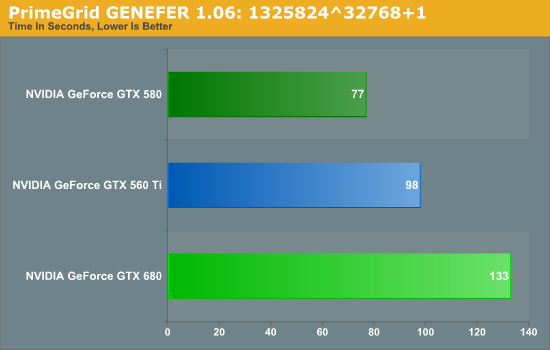
Because it’s based around double precision math the GTX 680 does rather poorly here, but the surprising bit is that it did so to a larger degree than we’d expect. The GTX 680’s FP64 performance is 1/24th its FP32 performance, compared to 1/8th on GTX 580 and 1/12th on GTX 560 Ti. Still, our expectation would be that performance would at least hold constant relative to the GTX 560 Ti, given that the GTX 680 has more than double the compute performance to offset the larger FP64 gap.
Instead we found that the GTX 680 takes 35% longer, when on paper it should be 20% faster than the GTX 560 Ti (largely due to the difference in the core clock). This makes for yet another test where the GTX 680 can’t keep up with the GTX 500 series, be it due to the change in the scheduler, or perhaps the greater pressure on the still-64KB L1 cache. Regardless of the reason, it is becoming increasingly evident that NVIDIA has sacrificed compute performance to reach their efficiency targets for GK104, which is an interesting shift from a company that was so gung-ho about compute performance, and a slightly concerning sign that NVIDIA may have lost faith in the GPU Computing market for consumer applications.
Finally, our last benchmark is once again looking at compute shader performance, this time through the Fluid simulation sample in the DirectX SDK. This program simulates the motion and interactions of a 16k particle fluid using a compute shader, with a choice of several different algorithms. In this case we’re using an (O)n^2 nearest neighbor method that is optimized by using shared memory to cache data.
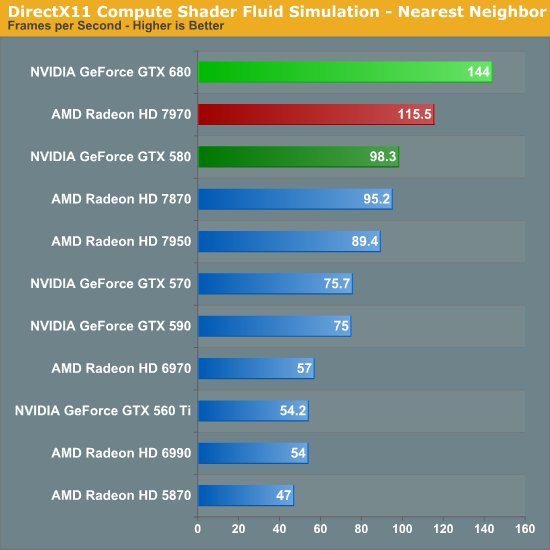
Redemption at last? In our final compute benchmark the GTX 680 finally shows that it can still succeed in some compute scenarios, taking a rather impressive lead over both the 7970 and the GTX 580. At this point it’s not particularly clear why the GTX 680 does so well here and only here, but the fact that this is a compute shader program as opposed to an OpenCL program may have something to do with it. NVIDIA needs solid compute shader performance for the games that use it; OpenCL and even CUDA performance however can take a backseat.










404 Comments
View All Comments
Sabresiberian - Thursday, March 22, 2012 - link
About what?Are you trying to blame the President for high video card prices?
Please.
CeriseCogburn - Thursday, March 22, 2012 - link
It's called inflation, try to get the idea, not some fanboy hurt.silverblue - Thursday, March 22, 2012 - link
What on earth is your problem? Where is there any sign of fanboyism in the three posts above you? He's got a valid point - cards are getting faster but they're getting more expensive at the same time.Successful troll is successful, it seems.
CeriseCogburn - Friday, March 23, 2012 - link
He said he got it in a sale. A few months ago it was $475 used on ebay (bitcoin).Many cards have come out at $500 and above.
The 580 was well over $500 for a long time, as was the 5870.
I guess you're mad because he;s wrong.
silverblue - Friday, March 23, 2012 - link
Reading comprehension isn't your friend. He's quite clearly talking about a 5870 that he bought for $325 when the prices were reduced two years back. He's also saying that there isn't a card in the region of $325 (give or take a few dollars) that is worth upgrading to right now, so in essence, he's asking what point there is to buying a new card.You're reading far too much into this. He still owns his 5870... which, by the way, never cost $500 at launch. The Eyefinity 6 Edition, perhaps, but not the vanilla 5870 - try $429 as an upper limit (and we're talking US Dollars; not my currency of choice but it's the norm for this site).
CeriseCogburn - Saturday, March 24, 2012 - link
Yes of course. So we have the 5870 v 7970 crysis W (page it happens to be on)40 vs 69
24 vs 42
16 vs 26
I see 3 resolutions where not or barely playable becomes playable.
So then it comes down to more exaggeration I objected to at the start.
I wouldn't object saying the 5870 can turn it down satisfy - but the increase is clearly game making.
Is it the GTX580 that was so far ahead yet denounced for core size and heat that is causing the disconnect ? I'd say so.
B-Unit1701 - Thursday, March 22, 2012 - link
Hence why Im still rocking a 4870. Picked one up almost exactly 3 years ago for $250, and haven't been convinced to upgrade until this generation. Will likely jump on a 7850 or a 7870 depending where prices land after nVidia's full launch.CeriseCogburn - Thursday, March 22, 2012 - link
The power envelope. The standard 300watts for pci-e (maybe they will raise it) is already exceeded on single cards.Where can you go but to 28mn and how is that not going to also bust power specs ?
Monitor resolutions have increased in 2 years.
OS has sucked up some.
Game patches enhance.
--
What's wrong is there is a limit that cannot be passed right now smaller nm must be achieved. Smaller ram with 4x the GB...
Two years may seem long but is it really ?
Many multi billion dollar upgrades to foundries require constant overhauls to move nodes.
Amazing is the whole thing hasn't collapsed already.
fhaddad78 - Thursday, March 22, 2012 - link
I'm confused by the dialog taking place in this conversation. Unless I am not understanding the results correctly, it seems to me the GTX 680 is a great card, there are some games where it performs really well, and there are other games where it's being outperformed by even older generation products. To me, this card (in it's current state) is more of a side-grade than an upgrade.Am I missing something?
prophet001 - Thursday, March 22, 2012 - link
only hysteria